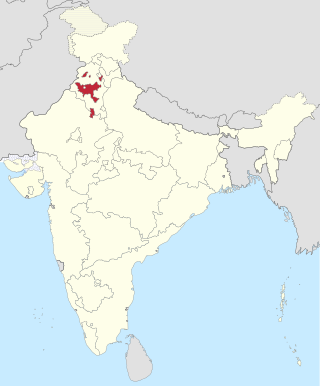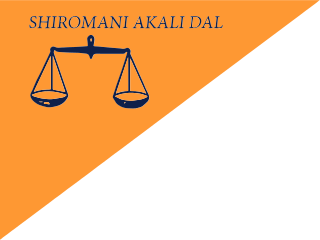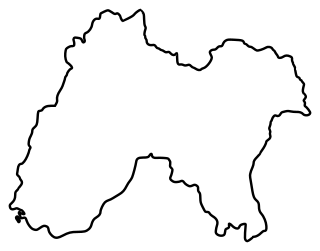Related Research Articles

Giani Zail Singh was an Indian politician from Punjab who served as the seventh president of India from 1982 to 1987. He was the first Sikh to become president.

The Punjabi Suba movement was a long-drawn political agitation, launched by Punjabi speaking people demanding the creation of autonomous Punjabi Suba, or Punjabi-speaking state, in the post-independence Indian state of East Punjab. The movement is defined as the forerunner of Khalistan movement.

The Patiala and East Punjab States Union (PEPSU) was a state of India, uniting eight princely states between 1948 and 1956. The capital and principal city was Patiala. The state covered an area of 26,208 km². Shimla, Kasauli, Kandaghat and Chail also became part of the PEPSU.

Captain Amarinder Singh, is an Indian politician, military historian, former royal and Indian Army veteran who served as the 15th Chief Minister of Punjab. A former Member of the Legislative Assembly, Punjab and Member of Parliament, Lok Sabha, he was also the president of Punjab Pradesh Congress Committee. He has also previously served as the Chief Minister of Punjab from 2002 to 2007 and 2017 to 2021. His father was the last Maharaja of the princely state of Patiala. He has also served in the Indian Army from 1963 to 1966. In 1980, he won a seat in the Lok Sabha for the first time. As of November 2022, Singh also serves as the chairman of the Punjab Urdu Academy. Captain Singh resigned as the Chief Minister of Punjab on 18 September 2021. On 19 September 2022 he merged his party PLC with BJP and joined BJP on the same day.

Sardar Hukam Singh was an Indian politician and the third Speaker of the Lok Sabha and second Deputy Speaker of the Lok Sabha from 1962 to 1967. He was also governor of Rajasthan from 1967 to 1972.
Jagmeet Singh Brar is an Indian politician, lawyer, writer and poet who belonged to the Shiromani Akali Dal. He represents the Lokhit Abhiyan political party.
Politics in reorganised present-day Punjab is dominated by mainly three parties – Indian National Congress, Aam Aadmi Party and Shiromani Akali Dal (Badal). Since 1967, Chief Minister of Punjab has been predominantly from Jat Sikh community despite its 21 percent state population. Exceptions are Giani Zail Singh, the Chief Minister of Punjab from 17 March 1972 to 30 April 1977 belonging to Ramgarhia community that has population of 6 percent and is a part of significant OBC community having population of 31.3 percent in the state and Charanjit Singh Channi who held the position for 111 days from 20 September 2021 to 16 March 2022 and was from Scheduled Caste(Dalit) who have 32 percent population in the state. Other prominent party is Bahujan Samaj Party especially in Doaba region founded by Kanshi Ram of Rupnagar district. In 1992 BSP won 9 seats Vidhan Sabha elections. Also BSP won 3 lok sabha seats from Punjab in 1996 general elections and only Garhshanker seat in 1997 Vidhan Sabha elections. Communist parties too have some influence in the Malwa area. In the 2014 general elections, the first-time contesting Aam Aadmi Party got 4 out of 13 seats in Punjab by winning 34 of the total 117 assembly segments, coming second in 7, third in 73 and fourth in the rest 3 segments. The support for the Aam Aadmi Party increased later in Punjab. The current Government was elected in the 2022 Punjab Assembly elections and the AAP won 92 out of 117 Assembly seats with Bhagwant Mann as the Chief Minister. The Congress flows down to get only 18 seats.

Fateh Singh was an Indian Sikh religious and political leader, and a key figure in the Punjabi Suba movement. He was revered as Sant Fateh Singh among his followers.
The list of members of political families of Punjab, India

The Shiromani Akali Dal (SAD) is a centre-right Sikh-centric state political party in Punjab, India. The party is the second-oldest in India, after Congress, being founded in 1920. Although there are many parties with the description Akali Dal, the party that is recognized as "Shiromani Akali Dal" by the Election Commission of India is the one led by Sukhbir Singh Badal. The party has a moderate Punjabi agenda. On 26 September 2020, they left the NDA over the farm bills.

Parkash Singh Badal was an Indian politician who served as the 8th Chief Minister of Punjab from 1970 to 1971, from 1977 to 1980, from 1997 to 2002, and from 2007 to 2017. He was also Leader of the Opposition in the Punjab Legislative Assembly from 1972 to 1977, 1980 to 1983 and from 2002 to 2007 and the 11th Union Minister of Agriculture and Farmers' Welfare in the Morarji Desai ministry from 1977 to 1977. He was the patron of Shiromani Akali Dal (SAD), a Sikh-centered regional political party, and the president of the party from 1995 to 2008, when he was replaced by his son Sukhbir Singh Badal. As the patron of SAD he exercised a strong influence on the Shiromani Gurdwara Parbandhak Committee and Delhi Sikh Gurdwara Management Committee. The Government of India awarded him the second-highest civilian award, the Padma Vibhushan, in 2015.
Gurbakshish Singh (1911-1983) was an Indian politician. He was Member of the Legislative Assembly (MLA) who represented the Barnala Constituency, in Punjab.

Elections to the Punjab Provincial Assembly were held in January 1946 as part of the 1946 Indian provincial elections.
The Interim East Punjab Assembly was a unicameral governing and law making body of the newly formed Indian state of East Punjab.

The 1952 Punjab Legislative Assembly election were the First Vidhan Sabha elections of the state when the Indian National Congress emerged as the largest party with 96 seats in the 126-seat legislature in the election. The Shiromani Akali Dal became the official opposition, holding 13 seats.

The 1957 Punjab Legislative Assembly election was the Second Vidhan Sabha election of the state when the Indian National Congress emerged as the largest party with 120 seats in the 154-seat legislature in the election. The Bharatiya Jana Sangh became the official opposition, holding 9 seats.
The 1967 Punjab Legislative Assembly election was the Fourth Vidhan Sabha election of the state. This was the first hung assembly. Indian National Congress emerged as the largest party with 48 seats in the 104-seat legislature in the election. The Akali Dal - Sant Fateh Singh became the second, holding 24 seats. On 28 August 1968, Assembly dissolved prematurely and president rule was imposed.
The 1969 Punjab Legislative Assembly election was the fifth Vidhan Sabha election of the state. This was the second hung assembly. Shiromani Akali Dal emerged as the largest party with 43 seats in the 104-seat legislature in the election. The Indian National Congress became the second, holding 38 seats. On 13 June 1971, Assembly dissolved prematurely and president rule was imposed.
The 1972 Punjab Legislative Assembly election was the sixth Vidhan Sabha election of the state. Indian National Congress emerged as the victorious party with 66 seats in the 104-seat legislature in the election. The Shiromani Akali Dal became the official opposition, holding 24 seats. On 30 April 1977, Assembly dissolved and president rule was imposed.
References
- ↑ "Former speaker of punjab vidhan sabha". speakerpunjab.gov.in. Retrieved 23 December 2021.
- ↑ page xiii of Punjab Vidhan Sabha Compendium . Punjab Legislative Assembly. Retrieved on 2 July 2019.
- ↑ Statistical Report of Punjab Legislative Assembly election 1964 (Pdf). eci.gov.in. Retrieved 31 December 2021.
- ↑ Amberish K. Diwanji. "A dummy's guide to President's rule". Rediff.com. 15 March 2005.
- ↑ Sarhali Assembly election. entranceindia.com. Retrieved 1 January 2021.
- ↑ S. R. Das. www.ebc-india.com. Retrieved 1 January 2021.
- ↑ Motions of Confidence and No-confidence in Lok Sabha and State Legislatures by G. C. Malhotra. P. 731-732.
- ↑ Motions of Confidence and No-confidence in Lok Sabha and State Legislatures by G. C. Malhotra. P. 732-733.
- ↑ Hindustan Times, 15 June 1964.
- ↑ Turmoil in Punjab Politics by S. C. Arora. P. 66
- ↑ Turmoil in Punjab Politics by S. C. Arora. P. 66
- 1 2 3 4 Doad 1997, p. 404.
- 1 2 3 Grewal 1998, p. 204.
- ↑ Singh, IP. "Future tense?". The Times of India. Retrieved 2 January 2022.
- ↑ The Sikhs as a "Minority" in a Sikh Majority State in India, by Paul Wallace, Asian Survey, 1986 University of California Press
- ↑ "The Punjab Reorganisation Act, 1966" (PDF). Government of India. 18 September 1966. Archived (PDF) from the original on 19 January 2012. Retrieved 2 January 2022.
- ↑ Deol 2000, p. 96.
- ↑ Turmoil in Punjab Politics by S. C. Arora. P. 80